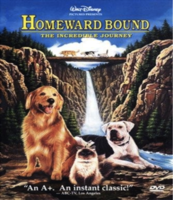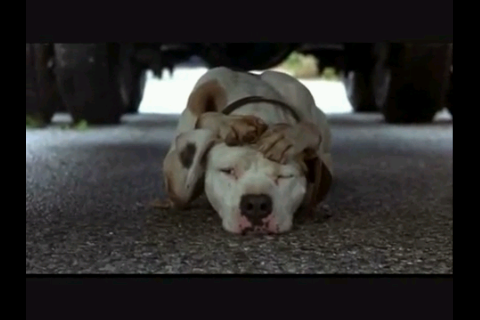
In our society and culture, there are many things that affect the relationships and views we have between ourselves and non-human animals; one major aspect being films that focus on animals. Particularly, in Homeward Bound, an adventure film, the fact that the animals were at the center of the film, that they were given human voices and emotions, and the fact that the main idea of the film was unconditional love between human and non-human animals definitely contributes to the perspectives we have in regards to human and non-human animals in our culture.
Homeward Bound is the story of three animals who set out on a journey in order to reunite with their very loved owners. The three main characters are a cat, voiced by Sally Field, an American bulldog, voiced by Michael J. Fox, and a golden retriever voiced by Don Adler. These three animals all belong to the same family and each animal is essentially the pet of one of the children. One day the family decides to go on vacation and leave the animals at a friend’s house. After a day or so, the animals feel as though it has been too long and that something is the matter. The animals then escape from the house they are staying at and set out on a dangerous journey to find their owners. Along the way, the cat almost drowns in a waterfall, the bulldog gets poked by a porcupine, they all end up in a pound and then escape, and the golden retriever gets stuck in a ditch. The family on the other hand leaves their vacation location in an attempt to locate their animals. After no success, they come back home and try to move on. After just a few days, all three of the animals arrive at the home and everyone lives happily ever after.
Homeward Bound is considered to be a Drama/Adventure movie. A movie that is included in the genre of “drama” is usually described as an in-depth look into the characters of the film dealing with emotional themes. According to the definition of a “dramatic” film, the themes are usually along the lines of alcoholism, drug addiction, infidelity, violence against women, etc; however, Homeward Bound is more along the lines of emotional conflict and unconditional love. The main character in these dramatic films is usually in conflict at a crucial moment of their lives and this conflict many times surrounds the family unit. Although it is not as serious as other dramatic films, it most definitely deals with a conflict surrounding the family unit, and also tugs at the emotions of the viewer in many ways. We all want to be loved and longed for in the way that these animals love and long for their owners. Along with this yearning for these emotions, we also deep down all want to see the happy ending materialize, which it does in this film. The other end of this genre is Adventure. Usually if a film is considered an Adventure film, the main focus of the film is an exciting task involving great risk or danger. An adventure is an event or series of events that happens outside the course of the protagonists ordinary life, usually accompanied by danger. This film would definitely constitute as an Adventure film; the main focus is a great journey that the animals take that involves a large amount of risk and danger. In another animal-based film, entitled Spirit: Stallion of the Cimarron, the genre was described was Western. These types of films usually have the main character involved in a battle against good and evil. When the main character is a non-human animal, it is more sympathetic to have an emotional conflict instead of a “good vs evil” conflict in order to allow the viewer to associate with the emotions and feelings of the character.
The fact that the three animals are the center of the film guide the viewer through the film and help to transport them into the center of the journey itself. When viewers watch films, the reason that the storyline evokes emotion, or does not, is based upon whether or not they can feel for the victim. The viewer attempts to live the story vicariously through the characters. In Homeward Bound, because the main characters are non-human animals, it allows the reader to view these non-human animals as if they occupy human traits. Another aspect of this is through the use of personification.
The use of human voices and language as well as emotions helps to personify the non-animal characters, which in turn contributes to the overall perspective many have in regards to non-human animals. The voices given to these non-human animals by the actors help to show how these characters feel. To the viewer, it is much easier to understand feelings and emotions when they are explained in human terms or shown to be somewhat human in emotion. Along with the language, the animals are shown doing certain physical movements that support the verbal explanation of their emotions. In Spirit: Stallion of the Cimarron, the horses were also the main characters of the movie. In this movie they did not have human voices, like in Homeward Bound; however, they horses did have facial expressions similar to human facial expressions which help to allow the viewer to feel what the characters are feeling.

The two aspects that contribute to the overall perspective society has regarding non-human animals is the personification of the animals and the main concept of unconditional love. The fact that the animals are given human voices, expressions, and emotions force the viewer to look at the animals as if they are human. This contributes to the idea that a dog, cat, or any other type of pet is a part of the family or occupies the same emotions and thoughts as the other members of the family. The idea of unconditional can have very negative consequences on society and culture. These types of films make viewers believe that animals are instinctively loyal, love their owners unconditionally, and if need be, would travel great lengths in order to be reunited with their owners. This can cause negative consequences in the fact that many people would possibly give up their pets if the pet had not acted in this expected way; for example, if a non-human animal had bitten their human counterpart, many humans believe that there is a problem with this animal because it is not loyal and it is not showing unconditional love. This could easily cause an increase in animals being left in shelters, or abandoned.